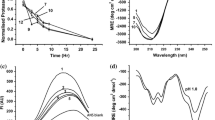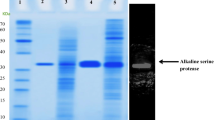Abstract
Halophilic salilysin is first synthesized as a pro-form, which has been shown autolysis activity to process pro-region (55 amino acids long) three times to form intermediate 1 (I1), intermediate 2 (I2) and final mature (M) salilysin. The autolysis of I1- to M-form salilysin in vitro was significantly accelerated with increasing NaCl concentration up to 4 M. Strong salting-out salts, (NH4)2SO4, Na2SO4 and MgSO4, were more effective, suggesting that autolysis is enhanced by inter-molecular association or structure compaction or both. However, MgCl2, a salting-in salt, was also effective, suggesting that other mechanisms, such as charge shielding and ionic binding to this halophilic protein, operated. Autolytic cleavage at site 3 resulted in mixed formation of correctly and incorrectly processed mature forms in the absence of salt, indicating that salt affected the accuracy of autolytic cleavage reaction. Far UV circular dichroism (CD) measurements indicated that E167A pro-salilysin showed an identical CD spectrum to the wild-type mature salilysin, suggesting pro-form has a proper fold for proteolytic activity. Thermal scanning indicated that E167A pro-salilysin was more heat-stable by ~ 10 °C than mature form. The CD spectra, thermal stability and modeling structure of salilysin clearly suggested that pro-salilysin is folded to the same structure as native form and is functional for autolysis.









Similar content being viewed by others
Data Availability
The datasets generated during and/or analysed during the current study are available from the corresponding author on reasonable request.
Abbreviations
- I1:
-
Intermediate 1
- I2:
-
Intermediate 2
- M:
-
Mature
- CD:
-
Circular dichroism
- NTA:
-
Nitrilotriacetic acid
- PAGE:
-
Polyacrylamide gel electrophoresis
- NaPB:
-
Na-phosphate buffer
References
Ventosa A, Nieto JJ, Oren A (1998) Biology of moderately halophilic aerobic bacteria. Microbiol Mol Biol Rev 62:504–544
Tokunaga H, Ishibashi M, Arakawa T, Tokunaga M (2004) Highly efficient renaturation of beta-lactamase isolated from moderately halophilic bacteria. FEBS Lett 558:7–12
Mevarech M, Frolow F, Gloss LM (2000) Halophilic enzymes: proteins with a grain of salt. Biophys Chem 86:155–164
Madern D, Ebel C, Zaccai G (2000) Halophilic adaptation of enzymes. Extremophiles 4:91–98
Tanaka R, Yamasaki S, Ishibashi M, Tokunaga H, Arakawa T, Tokunaga M (2020) Salt-enhanced processing, proteolytic activity and stability of halophilic thermolysin-like proteinase, salilysin, isolated from a moderate halophile, Chromohalobacter salexigens DSM3043. Int J Biol Macromol 164:77–86
Laemmli UK (1970) Cleavage of structural proteins during the assembly of the head of bacteriophage T4. Nature 227:680–685
Smith PK, Krohn RI, Hermanson GT, Mallia AK, Gartner FH, Provenzano MD, Fujimoto EK, Goeke NM, Olson BJ, Klenk DC (1985) Measurement of protein using bicinchoninic acid. Anal Biochem 150:76–85
Mizukami M, Tokunaga H, Onishi H, Ueno Y, Hanagata H, Miyazaki N, Kiyose N, Ito Y, Ishibashi M, Hagihara Y, Arakawa T, Miyauchi A, Tokunaga M (2015) Highly efficient production of VHH antibody fragments in Brevibacillus choshinensis expression system. Protein Expr Purif 105:23–32
Hofmeister F (1888) Zur Lehre von cer Wirkung der Salze. Arch Exp Pathol Pharmacol 24:247–260
Ishibashi M, Arakawa T, Tokunaga M (2003) Salting-in effects offset MgCl2-induced refolding of nucleoside diphosphate kinase. Protein Pept Lett 10:575–580
Ishibashi M, Tsumoto K, Ejima D, Arakawa T, Tokunaga M (2005) Characterization of arginine as a solvent additive: a halophilic enzyme as a model protein. Protein Pept Lett 12:649–653
Arakawa T, Timasheff SN (1982) Preferential interactions of proteins with salts in concentrated solutions. Biochemistry 24:6545–6552
Wang A, Robertson AD, Bolen DW (1995) Effects of a naturally occurring compatible osmolytes on the internal dynamics of ribonuclease. Biochemistery 34:15096–15104
Baskakov IV, Bolen DW (1998) Monitoring the sizes of denatured ensembles of staphylococcal nuclease proteins: implications regarding m values, intermediates, and thermodynamics. Biochemistry 37:18010–18017
Arakawa T, Timasheff SN (1984) Mechanism of protein salting in and salting out by divalent cation salts: balance between hydration and salt binding. Biochemistry 23:5912–5923
Rivas G, Minton AP (2016) Macromolecular crowding in vitro, in vivo, and in between. Trends Biochem Sci 41:970–981
Demidyuk IV, Gasanov EV, Safina DR, Kostrov SV (2008) Structural organization of precursors of thermolysin-like proteinases. Protein J 27:343–354
Demidyuk IV, Kalashnikov AE, Gromova TY, Gasanov EV, Safina DR, Zabolotskaya MV, Rudenskaya GN, Kostrov SV (2006) Cloning, sequencing, expression, and characterization of protealysin, a novel neutral proteinase from Serratia proteamaculans representing a new group of thermolysin-like proteases with short N-terminal region of precursor. Protein Expr Purif 47:551–561
Demidyuk IV, Gromova TY, Polyakov KM, Melik-Adamyan WR, Kuranova IP, Kostrov SV (2010) Crystal structure of the protealysin precursor: insights into propeptide function. J Biol Chem 285:2003–2013
Inouye K, Kusano M, Hashida Y, Minoda M, Yasukawa K (2007) Engineering, expression, purification, and production of recombinant thermolysin. Biotechnol Annu Rev 13:43–64
Acknowledgements
We would like to thank M. Shimoyanagita, T. Yamashiro and N. Nagato for their study, discussion and helps.
Funding
This work was supported by Grant in Aid for Science Research (KAKENHI 20580372) from The Ministry of Education, Culture, Sports, Science and Technology (MEXT)Japan. This study was also supported by Sankei Science Foundation and by Institute for Fermentation, Osaka.
Author information
Authors and Affiliations
Contributions
MT corresponding author, conceptualization, investigation, and writing-original draft. MI investigation and formal analysis. RT and SY investigation. HT investigation and reviewing. TA writing—review & editing.
Corresponding author
Ethics declarations
Conflict of interest
The authors declare that they have no conflict of interest.
Additional information
Publisher's Note
Springer Nature remains neutral with regard to jurisdictional claims in published maps and institutional affiliations.
Rights and permissions
About this article
Cite this article
Ishibashi, M., Tanaka, R., Yamasaki, S. et al. Salt Mediated Modulation of Autolysis of Thermolysin-Like Proteinase, Salilysin, Isolated from a Moderate Halophile, Chromohalobacter salexigens DSM3043. Protein J 40, 223–233 (2021). https://doi.org/10.1007/s10930-021-09964-x
Accepted:
Published:
Issue Date:
DOI: https://doi.org/10.1007/s10930-021-09964-x




